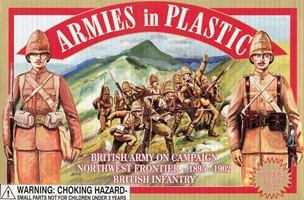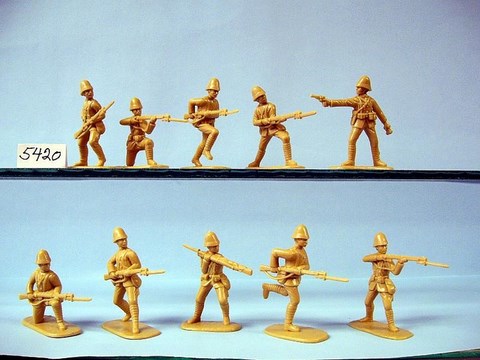20 Pathans for priming and painting - a full Armies in Plastic box. This is a great box, perfect for the period in all respects, lively poses, good selection of weapons.
Next to 15mm WWII - ginormous!
PATHAN PAINTING NOTES
Summarized from:
Osprey "Northwest Frontier": Wilkinson-Latham, Robert
Osprey #219 "Victorias Enemies (3) India: Knight, Ian
"The Frontier Ablaze: The North-West Frontier Rising 1897-98": Barthorp, Michael
General
- Basic Garments:
kullah = headgear, a stitched pointed cap [may be decorated];
kufi = popular patterned Muslim skull cap; regional variations, can be pillbox style
angarka = loose blouse or smock
lungi / pagri = long scarf, or sash tied around waist, or around kullah for a turban; can have contrasting stripes perpendicular to length; as turban, appear angled.
poshteen = reverse goatskin vest or coat [embroidered more if more status]
chadar = shawl
pyjama? = baggy trousers, partig were gathered at ankles
chapplis = sandals
Most garments were off-white, but some colors were worn.
- Tribes had predominant but not uniform color combinations:
Waziri = turban in dark red or indigo blue, lungi in dark blue/red or pink
Kurram Valley = dark blue angarka w' white patches [similar to dervishes]
Afridis in Khyber Pass [also Mamunds and Swatis] = grey or blue angarka [but mostly white?] w' off-white trousers. Lungi has contrasting stripes at ends perpendicular to length.
Bunerwals = dark blue or black garments
Many captured items of gear would be used, such as ammo pouches.
- Weapons
talwar = curved sword
chora = triangular knife of various lengths, single-edge blade tapering hilt to point
dahl = shield, round engraved metal, or heavy leather w' metal bosss and studs
jezail = long matchlock rifle
I have some interesting choices with the Pathans I've primed. I did prime them half tan and half white, and I think they have the right look. The white will be the common off-white, and the tan will be Kurram Valley, perhaps - they sound unusual!
Tabletop Minions Atom Smasher commentary
https://www.youtube.com/watch?v=5vfJdCimmKA
On to the painting mines!
https://www.youtube.com/watch?v=5vfJdCimmKA
- brand not important - $6 for 5 brushes fine
- large synthetic brushes for big areas, small natural brushes for detail work
- clean with hair conditioner, leave in it overnight
- hair tie around water cup holds brushes overnight
- use the back end of the brush to get out the paint, not the bristles
- keep paint away from the farrel - only halfway down the bristles
- metallic paints wear bristles faster
- use different paints for metallic so the sparkles don't appear elsewhere
- Windsor Newton, Manila Road
- Vallejo Brush Cleaner
On to the painting mines!







































































